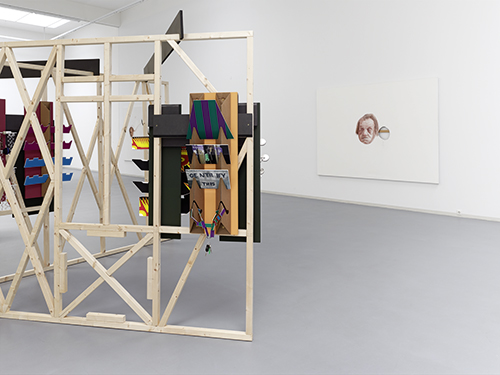Her Story(s)
Bonner Kunstverein
Bonner Kunstverein

It’s no small curatorial task to summarize 50 years of institutional history in a group show. It might be harder still to summarize 50 years of feminism. To celebrate its half-century this year, the Bonner Kunstverein has tackled both – a thorny, maybe impossible task with predictable pitfalls and a limited number of unpredictable solutions. Curator Fanny Gonella faced the project with eyes wide open, and the resulting show, Ihre Geschichte(n), owns up to its outsized ambition by addressing its intrinsic limitations.
Since its establishment in 1963, the Kunstverein has held a number of explicitly feminist shows and has continuously exhibited work by women in the still male-dominated art world. Its first wide-reaching feminist show was the 1981 exhibition Typisch Frau (‘Typical Woman’), put together by then chair(wo)man Margarethe Jochimsen and gallerist Philomene Magers (the mother of the current gallerist of the same name). The press release for this 54-woman show emphasized its ‘seismographic qualities’ – its aim was not to summarize a moment or present a unified feminist agenda but to trace a multiplicity of viewpoints.
Ihre Geschichte(n) was similarly seismographic. Its title is an idiomatic translation of the English ‘herstory’ – a neologism coined in the 1970s to counterbalance the conventional, androcentric ‘his’tory. Yet its parenthetical ‘n’ pluralizes the story. Gonella avoided creating a singular curatorial narrative by asking seven participating artists to invite a feminist predecessor who had previously exhibited at the Kunstverein to accompany them in the show. Three out of the seven artists were men: rather than promoting gender equality through reciprocal exclusion, this tactic acknowledges men’s place in ‘her’stories – perhaps even advocating a move beyond the gender binary altogether.
Rita McBride asked Marlene Dumas to help her put together a wall-hanging including work by Melissa Gordon, Petra Maitz and Anne Pöhlman. Its many pieces include McBride’s ongoing series, Sex Toys (2010), amorphous, elongated objects on sticks, and a scarily outsized pleated tartan skirt by Maitz. The conglomeration is a startling patchwork of styles, emphasizing the intrinsic arbitrariness of selecting only a few artists to represent such a wide-ranging movement (compare the seven principal artists in this show to the 54 women in Typisch Frau – however broad the selection, someone will be left out).
Monika Baer invited herself. Baer was awarded a stipend by the Kunstverein in 1998, and re-exhibited two of her paint‑ings from that period. The paintings are sparse figurative gestures on white canvas: in one, a pig’s head takes the place of the nose on an abstracted woman’s face. The paintings seem young, slightly simplistic. By inviting a previous version of herself, Baer references the evolution of her own feminism: ‘the personal is political’, as the feminist adage goes.
By far the show’s most energetic contribution is by Christian Falsnaes, who seized on the opportunity for vigorous social interaction. Falsnaes addressed social constructions of masculinity in four video works resulting from a performance he held in the exhibition space before the show opened, which involved a group of Bonn residents. The work is a homage to Marianne Wex’s 1979 show at the Kunstverein: ‘Weibliche’ und ‘männliche’ Körpersprache als Folge gesellschaftlicher Machtverhältnisse zwischen Mann und Frau (‘Feminine’ and ‘Masculine’ Body Language as a Result of Societal Power Relations Between Man and Woman). Falsnaes’ title, Männliches Auftreten als Folge gesellschaftlicher Machtverhältnisse zwischen Künstler und Publikum (Male Appearance as a Result of Societal Power Relations Between Artist and Public, 2013), suggests that male identity is as much a construction as female. He pokes fun at this by enacting four male artist personality tropes: ‘artist entertainer’, ‘artist teacher’, ‘artist guru’ and ‘artist provocateur’.
Yanking politicized works from the past and placing them in a present-day context can result in a curiosity cabinet (or thrift store) of attempts at radical social change that didn’t exactly come to fruition. Often those works rely on their initial, contextual antagonism to stay charged. Yet by asking both male and female contemporary artists to exhibit alongside their feminist predecessors, Gonella re-vivified the older works in Ihre Geschichte(n), imbuing them with new meaning and allowing them to evolve. Something is always lost in translation – but here, the act of translation became a crucial and compelling part of the story itself.














